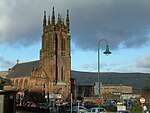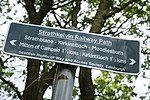Kirkintilloch railway station
Beeching closures in ScotlandDisused railway stations in East DunbartonshireFormer North British Railway stationsKirkintillochPages with no open date in Infobox station ... and 4 more
Railway stations in Great Britain closed in 1964Railway stations in Great Britain opened in 1848Scotland railway station stubsUse British English from January 2017
Kirkintilloch railway station served part of Kirkintilloch in Scotland. The station was constructed by the Edinburgh and Glasgow Railway, which became part of the North British Railway.
Excerpt from the Wikipedia article Kirkintilloch railway station (License: CC BY-SA 3.0, Authors).Kirkintilloch railway station
Peter D Stirling Road,
Geographical coordinates (GPS) Address Nearby Places Show on map
Geographical coordinates (GPS)
| Latitude | Longitude |
|---|---|
| N 55.941 ° | E -4.153 ° |
Address
Campsie View Care Home
Peter D Stirling Road
G66 1PG , Barleybank
Scotland, United Kingdom
Open on Google Maps







